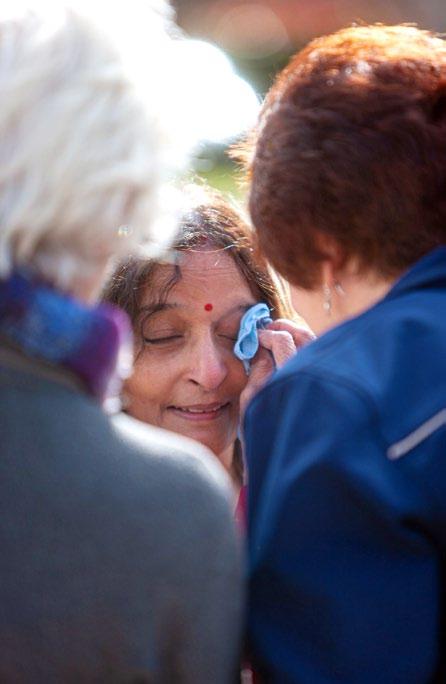
14 minute read
Guard of honour for Dr velu
from 2020-07 Melbourne
by Indian Link
The town of Crookwell NSW thanks Indian-origin doctor, retiring after 45 years of service

BY RAJNI ANAND LUTHRA
At a time when polarisation and otherness have come to dominate so much of our social discourse, the story of Crookwell’s Dr Velu warms the heart for its inclusiveness and acceptance.
This month, as Dr Velu retired after 45 years of service at NSW’s Crookwell District Hospital, he agreed to attend a farewell lunch organised by colleagues.
Pleasantly surprised as a convertible arrived to pick him and his wife Chandra, he couldn’t have guessed there was much more than lunch waiting for him.
The drive down the city’s main street will be one he and his family will remember for the rest of their lives.
Townspeople lined the street to felicitate him, thanking a man who cared for them for most of his career as a doctor.
“He delivered half the town as babies, saved countless lives, and held the hand of so many as they have passed,” said an ABC report that has gone viral in Australia’s Indian community.
“I didn’t know what to say,” Dr Velu told Indian Link. “I was overwhelmed, embarrassed even. I felt like I was in a dream.”
The grand send-off was organised by a ‘committee’ of colleagues from the medical fraternity.
“I’ve known them all for many years, but they kept the ‘operation’ a secret,” he laughed.
The event was two to three months in the making, he would learn later.
Police and local council approvals were sought to have the main street kept clear; businesses were alerted, and notices sent out in the shopping bags at the local IGA and in letterbox drops.
The response was enormous. Grateful locals came out with placards, and the three schools along the route had the kids lined up at the fence, cheering and waving.
“Small towns are like that,” mused Dr Velu. “People are affectionate, the community spirit is strong.”
He recalled the time when two other local heroes were similarly felicitated, Hockeyroos Emily Smith and Kellie Miller after leading their team to a Commonwealth Gold.
Dr Ramaswamy Thangavelu arrived in Australia in 1970 from Tamil Nadu in India to take up a position as surgeon at Lockhart in NSW’s Riverina region.
“The special plane that brought me to the town, landed in the paddock,” he remembered with fondness.
Five years later, he moved to Crookwell near Goulburn to work at the District Hospital, at the behest of the hospital’s anaesthetist Dr Krishnan. Together they performed surgeries for four decades.
(An Erode lad, Dr Velu took his medical degree from Chennai Medical College and a Master’s in Surgery from Stanley Medical

College Chennai, where he also worked briefly as Associate Professor of Surgery.)
“To new migrants, I would say, try living and working in the country,” Dr Velu advised. “Your services will be welcome and appreciated in the small towns. You’ll become part of the community and experience the true spirit of what it is to be Australian.”
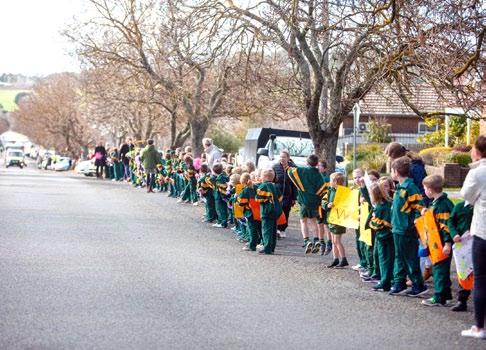
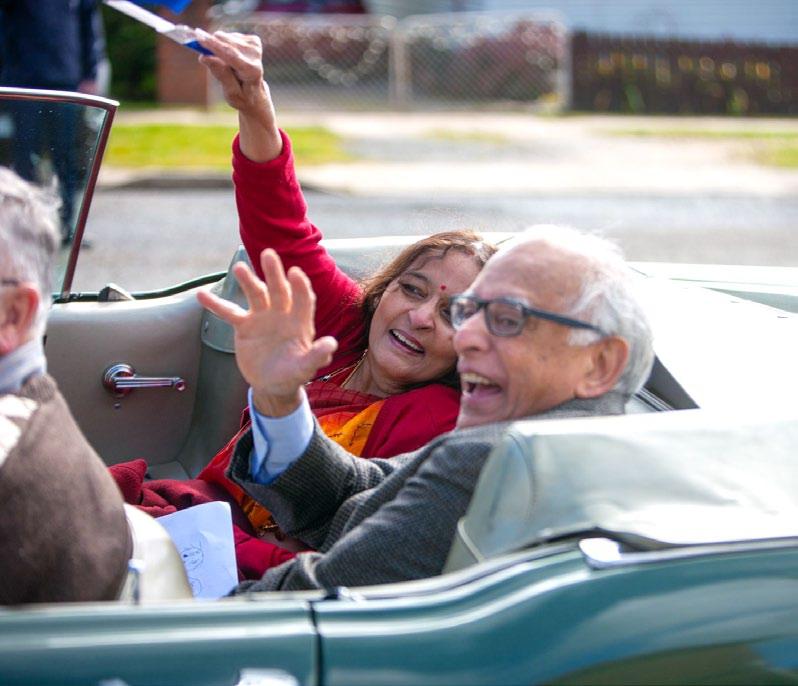
He took a moment to thank his wife Chandra, who manages the surgery where he will continue to work as a GP. “Chandra has put up with me very patiently – even when I worked 24 hours a day in the early years. She’s well integrated in the community here, involved in many activities.”


Their daughter Veena came in from Melbourne for the occasion, and son Visu arrived from Sydney with his wife Vanitha and kids Roshan and Shiva. Veena said later, “I’m really proud of my parents, and so very touched by this outpouring of love.”
As for Dr Velu himself, he concluded with humility, “I don’t think I did anything extraordinary – I just love my work.”
When a 103-year-old Indian man defeated the coronavirus
In a huge relief for his anxious family, a sprightly 103-year-old Sikh man has vanquished the coronavirus and returned home to savour the victory.
Now ranked India’s oldest ICU survivor of COVID-19, Sukha Singh Chhabra of Thane was happily discharged from the city’s Kaushalya Medical Foundation Trust Hospital (KMFT) in June.
His younger brother 86-year-old Tara Singh who was also infected, was discharged from the hospital a couple of days after him.
For nearly a month, Chhabra’s entire family was on tenterhooks although he remained largely unaware of the potentially deadly infection that had afflicted him.
“We downplayed it and requested him to get admitted to a hospital for proper care,” his 39-year-old grandson Gurdeep K. Chhabra explained. “He agreed without any fuss, so we didn’t see any point in unnecessarily alarming him at his advanced age.”
After his swabs tested positive, he was wheeled into the KMFT Hospital on 2 June. His sons and grandchildren prayed, while his young great-grandchildren waited for him to return home to play with them.
Chhabra’s brother Tara Singh had come to visit the family briefly and lived with his elder brother, and hence got infected. He was admitted to the same hospital and spent days in the ICU.
Chhabra’s month-long stay in hospital was mostly lonely and without the hustle-bustle of his large family due to the COVID-19 protocols. Still, the senior Lahore (Pakistan)born man braved it remarkably well.
“He was twice in and out of the intensive care unit, required non-invasive ventilation, inotropic supports to maintain his heart and lung functions for moderate Acute Respiratory Distress Syndrome, along with COVID Pneumonia,” said Amit Lala Khomane, Head of Critical Care Medicine at the hospital. “He had a very tricky course, going uphill and coming downhill.”
A special team of doctors was assigned to treat Chhabra on the long road to recovery. However, they generously acknowledged that “it was the patient’s own determination to fight out COVID-19 at this advanced age” which was very important.
“We as doctors left no stone unturned to keep him and our other patients, to win this battle,” said a doctor.
Marvelling at Chhabra’s “miraculous recovery”, the KMFT Trustees Amol Bhanushali and Sameep Sohoni decided to waive off the treatment costs for Chhabra.
After he was accorded a warm send-off with a resounding round of applause, the weary Chhabra returned to the comfort and safety of his home.
“Before lockdown, he was very active as usual. He even visited the Gurudwara Shri Dashmesh Darbar, climbed the stairs independently, prayed, took ‘prasad’ at the langar and returned home,” said Gurmukh Singh, President of the Gurudwara and Shiv Sena Municipal Corporator from Thane. Despite the recovery, Chhabra remains quite weak and has been on an intravenous semi-liquid diet since.
Indian Navy repatriated 3,992 citizens during the pandemic
The Indian Navy has brought back 3,992 citizens from various countries stranded due to the COVID pandemic, the force announced. In May, the Navy had launched Operation Samudra Setu as part of the national effort to bring back Indian citizens from overseas during the pandemic.
Indian Naval ships Jalashwa (Landing Platform Dock), and Airavat, Shardul and Magar (Landing Ship Tanks) participated in this operation which lasted over 55 days and traversed more than 23,000 kilometres by sea.
The Indian Navy has previously undertaken similar evacuation operations as part of Operation Sukoon in 2006 (Beirut) and Operation Rahat in 2015 (Yemen).
The COVID pandemic has had a significant impact on ships and seafarers due to the compact environment and forced ventilation systems onboard ships.
“It was in these trying times and difficult conditions that the Indian Navy took up the challenge to evacuate our distressed citizens from overseas,” Commander Vivek Madhwal said.
The greatest challenge for the Indian Navy was to avoid any incident of outbreak of infection onboard the ships during the evacuation operation. “Rigorous measures were planned and medical/safety protocols unique to the operating environment of ships were implemented. These were strictly followed onboard the ships undertaking Op Samudra Setu resulting in the safe return of 3,992 of our citizens to their homeland,” the officer said.
Operation Samudra Setu was undertaken utilising Indian Naval ships best suited for the operation, catering for COVID related social distancing norms vis-a-vis medical arrangements and carrying capacity.
Ships used for the operation were specially provisioned and the sick bay or the clinic onboard was especially equipped with COVID related equipment and facilities.
Women officers and military nursing staff were also embarked for the women passengers. Basic amenities and medical facilities were provided to all evacuees during sea passage on these ships.
An expectant mother who undertook passage on Jalashwa gave birth to a baby boy within a few hours of reaching Kochi on International Mother’s Day.
Along with other government agencies, the Navy has also been at the forefront of national efforts to assist Indian citizens. The Navy’s IL-38 and Dornier aircraft have been used for ferrying doctors and COVID related material across the country.
Indian Naval personnel also innovated various customised equipment such as Personnel Protection Equipment NavRakshak, hand-held temperature sensors, assisted respiratory system, 3-D printed face shield, portable multi-feed oxygen manifold, ventilators, air evacuation stretcher pod, baggage disinfectants etc. Most of these innovations were carried onboard the ships undertaking Op Samudra Setu and niche equipment was also provided to the host countries from where evacuation was undertaken.
21-year-old Meera Mehta receives UK’s The Diana Award
21-year-old Meera Mehta is a young COVID-19 warrior and latest recipient of The Diana Award. She volunteers with the global non-profit Shrimad Rajchandra Love and Care and has been awarded the most prestigious accolade a young person aged 9-25 years can receive for their social action or humanitarian work.
Given out by The Diana Award charity and supported by The Duke of Cambridge and The Duke of Sussex, the Diana Award is awarded to young changemakers. This year, 23 young Indians between 11 to 25 years old have received the award.
“We congratulate all our new Diana Award recipients who are changemakers for
The artwork ‘Imperceptible Warriors’ by Venkatesh Sabbaravapu captures the plight of migrant labourers who lost their livelihood in the cities and were forced to walk back to their villages. It is featured in an ongoing online exhibition ‘The Spirit Remains Unlocked.’ their generation. We know by receiving this honour they will inspire more young people to get involved in their communities and begin their own journey as active citizens,” said TessyOjo, CEO of The Diana Award.
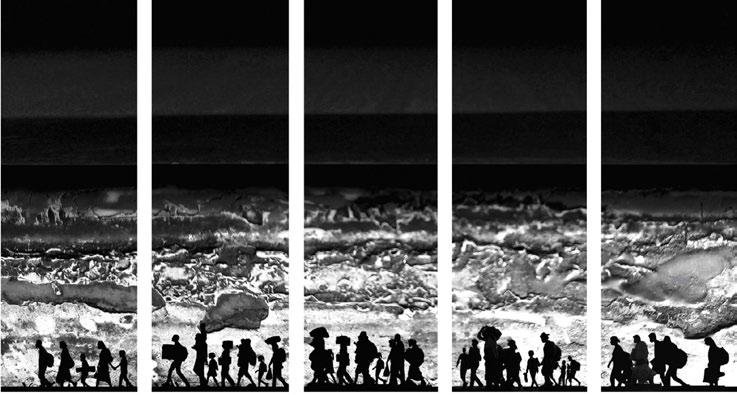
Since the tender age of six, Meera has been inspired by Pujya Gurudevshri Rakeshbhai, founder of Shrimad Rajchandra Love and Care, to volunteer for various projects for the remote communities of South Gujarat with the belief “Make compassion your nature, not hobby, habit or mood.”
“I will always remember the day at the first tribal camp I visited. When I gave a tribal child a gift, Pujya Gurudevshri Rakeshbhai encouraged me to say thank you to that child and told me that it is a privilege to be able to serve the less fortunate,” said Meera. “What Pujya Gurudevshri taught me changed my entire perspective towards fundraising. While I continue to actively raise funds, I am also studying hard to become a doctor, and help tribal children in more ways than one.”
Implementing this teaching, Meera raised enormous funds for many initiatives including the health and education projects, tertiary healthcare for a rural charity hospital, a Science college for the tribal students, primary and secondary education for indigenous communities, an ICU unit for new-born, and a skill development program for rural women.
She raised over Rs 33 lakhs to support vulnerable communities during the pandemic. With that amount, she was instrumental in sponsoring 2 buses for migrant workers to return to their hometown in Bihar, providing over lakhs of meals for daily wagers and support to thousands frontline workers with PPE Kits and masks.
Across her 10-year journey, Meera has raised over Rs 1.5 crore, garnering massive support from corporates, celebrities and organisations.
Other Indians who won The Diana Award this year include 17-year-old Nandani Agarwal who works towards improving India’s organ donations; 11-year-old Adrika Goyal who teaches self-defence to empower girls in her community; and 22-year-old Neeraj Murmu who established a local school for underprivileged children.
Five Indians who died serving UN among those honoured
In a ceremony honouring those who lost their lives while serving the world body in the past year, the United Nations has honoured five Indians for their service.
Speaking at the memorial service, Secretary-General Antonio Guterres said, “That so many of our colleagues choose to serve where risk prevails is testament to their unstinting commitment to helping the world’s most vulnerable people, who rely on us for peace, shelter, food, vaccinations and so much more.”
A health worker screens residents for COVID-19 symptoms at Deonar slum in Mumbai, India, July 11, 2020. In just three weeks, India went from the world’s sixth worst-affected country by the coronavirus to the third, according to a tally by Johns Hopkins University. India's fragile health system was bolstered during a stringent months-long lockdown but could still be overwhelmed by an exponential rise in infections.
The annual ceremony was held online because the UN headquarters is under a COVID-19 pandemic lockdown.
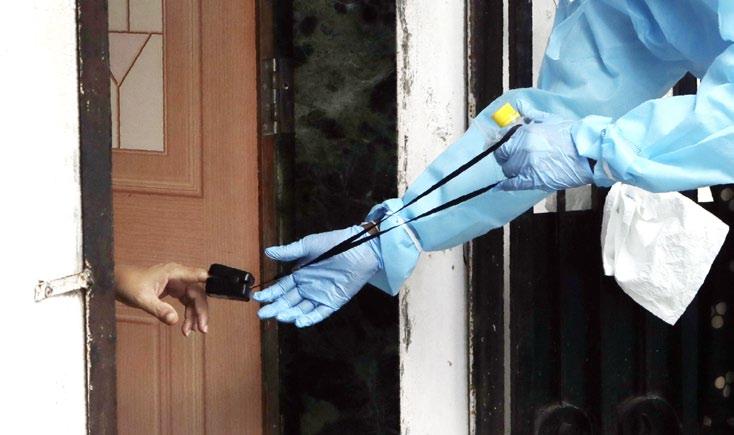
“Our friends and colleagues paid the ultimate sacrifice in the service of humanity,” said Under-Secretary-General for Operational Support, Atul Khare. “Their legacies will live on as we carry forward the noble cause of the UN.”
A total of 77 people, both civilians and military personnel, were honoured at the ceremony.
Among them, Lt Col Gaurav Solanki, died in the Democratic Republic of Congo (DRC) while trying to rescue a colleague from drowing in Lake Kivu.He was a peacekeeper with the UN Stabilisation in the DRC, which is known by its French initials as MONUSCO.
The others honoured were Johnson Beck with UN Disengagement Observer Force (UNDOF) in the Golan Heights between Israel and Syria; Havildar Ramesh Singh with UN Interim Force in Lebanon (UNIFIL); Major Ravi Inder Singh Sandhu and Havildar Lal Manotra Tarsem with UN Mission in South Sudan (UNMISS).They had earlier received the UN’s Dag Hammarskjold medal.
Historically India is the biggest troop contributor to the UN peacekeeping operations.
During the International Peacekeepers Day observance in May, India’s Permanent Representative T.S. Tirumurti said, “India’s long-standing UN peacekeeping contribution has not come without cost. India has lost more peacekeepers than any other member state of the UN.”
58 Indian-origin executives account for $1 trillion in revenue globally
A new list by an Indian diaspora organisation has found that a group of 58 Indian-origin executives around the world account for a combined $1 trillion in revenue. According to Indiaspora, a US-based not-for-profit organisation, Indianorigin executives collectively employ more than 3.6 million people.
“We wanted to capture this incredible feat that our community is achieving with increasing numbers,” said MR Rangaswami, a Silicon Valley-based entrepreneur and investor and founder of Indiaspora.
Some of the executives in the list are as young as 37 years old, with the median age being 54 years old.
“The impact that the Indian diaspora is having in the realm of business is remarkable. It’s one of the reasons we launched this project, and we hope our lists will continue to raise the profile of those who have reached the very top of their fields while also serving as agents for positive change,” Rangaswami said.
The list of Indian-origin CEOs includes professionals in Singapore, US, UK, Uganda, and Ethiopia.
“There used to be only a handful of us leading corporations. Now that we are reaching prominence, I am eager to see how the next generation leaves its own legacy,” said Raj Gupta, an Indiaspora member and Chairman of two companies on the list, Aptiv and Avantor.
He was one of the first executives of the Indian diaspora to join the ranks of corporate leadership along with Indra Nooyi of PepsiCo and Dinesh Paliwal of Harman International.
“I’m amazed to see how far we’ve come in terms of representation in business.”
800,000 Indians could be forced to leave Kuwait
A draft expat quota bill in Kuwait could result in 800,000 Indians forced to leave the Gulf state, a media report said
According to the bill, deemed constitutional by Kuwait's National Assembly's legal and legislative committee, Indians should not exceed 15 per cent of the population.
Due to this, 800,000 Indians might have to leave Kuwait, as the Indian community is the largest totalling 1.45 million.
Since the beginning of the COVID-19 pandemic, there has been a spike in anti-expat rhetoric as lawmakers and governmental officials call for reducing the number of foreigners in Kuwait.
Last month, Kuwait's Prime Minister, Sheikh Sabah Al Khalid Al Sabah, proposed decreasing the number of expats from 70 per cent to 30 per cent of the population.
The current population of Kuwait is 4.3 million, with Kuwaitis making up 1.3 million of the population, and expats accounting for 3 million.
Apu from ‘The Simpsons’ will no longer be voiced by a white actor
Perhaps the most famous Indian character on TV, Apu Nahasapeemapetilon of The Simpsons will no longer be voiced by a white actor. Voice actor Hank Azaria had been the voice of Apu since 1990.
“Moving forward, The Simpsons will no longer have white actors voice non-white characters,” the makers of the show said in a statement.
The Simpsons has been on air since the late 1980s and has many characters of different ethnic backgrounds. In the past few years, many have pointed out the stereotype of Apu, an Indian-American immigrant who runs a store.
In January, Azaria had voiced his discomfort with essaying the role. He said that he “didn’t want to participate in it anymore” and “just didn’t feel right.”
Back in 2017, comedian Hari Kondabolu’s documentary The Problem With Apu critiqued the South Asian stereotype shown by The Simpsons. As the only Indian character in popular culture for a long time, Apu’s accent and mannerisms reinforced negative stereotypes. The documentary also featured inputs from other South AsianAmerican entertainers like Hasan Minhaj, Aziz Ansari, and Kal Penn.
At the time, The Simpsons creator Matt Groening was dismissive of this criticism.
“I’m proud of what we do on the show. And I think it’s a time in our culture where people love to pretend they’re offended,” he had stated.
This recent announcement about Apu follows a number of white celebrities stepping down from non-white roles. These include Jenny Slate as biracial character Missy in Big Mouth and Kristen Bell as biracial character Molly in Central Park.
Indian artists document lockdown in online exhibition
A remote arts residency in India that began on the first day of the nationwide lockdown, featuring 30 artists confined in homes and studios in a multitude of locations, has culminated in an extensive online exhibition ‘The Spirit Remains Unlocked.’
The exhibit presents unique vignettes of artists’ experiences of these unprecedented times we face.
With temporary closure of exhibition spaces and a COVID-19 downturn faced by artists as the backdrop, the online exhibition had artists who were forced to focus on what they do best – create art. A celebration of the resilience and unrestrained creative spirit of artists, the exhibition is curated and conceived by art curator, consultant and founder of The Art Route, Lubna Sen. The exhibition and a virtual gallery tour can be accessed on theartroute.com until August 15.
On view is ‘Imperceptible Warriors’ by Venkatesh Sabbaravapu – it captures the plight of migrant labourers who lost their livelihood in the cities and were forced to walk back to their villages.
NitashaJaini’s ‘Lockdown Drawing’ series touches upon domestic violence inflicted upon victims forced to co-exist with their tormentors under the same roof.
Rahul Swami’s digital art, ‘Finding a Better You’ expresses how this time led us to discover better versions of ourselves.
Giving out hope, a photograph by Vijay Singh, of a young woman peering out from indoors is aptly titled, ‘Window of Hope’.
In Kanika Singh’s mosaic installation, ‘Filling in the Blues with Sunshine’, the need for human warmth comes alive in sunflowers turning towards each other to compensate for the lack of sunshine.
Lubna Sen says the exhibition is a step into a new recalibrated world going increasingly digital.
“We are going through an unprecedented time in our lives,” she shares. “The COVID-19 pandemic will also have a far-reaching effect on the economy and the art world will be of no exception. The immediate cascading effect of this downturn is already being faced by the artists. With all major physical events coming to a pause, artists are losing opportunity to showcase and promote their works, something which is vital for their survival.”
She adds, “From this remotely-organised online art residency project emerged a visual documentation of a historic event. This snapshot of history was captured by this eclectic group of artists who reacted and responded to the unfolding events, and eventually evolved personally from the experience.”
Ready to showcase to the world what ‘unlocked spirits’ can do, ‘The Spirit Remains Unlocked’ is a not-to-be-missed opportunity to feel one with the artists and the larger humankind, and relive in their depictions your own multi-faceted experiences of braving the lockdown.
In the spirit of giving back to society, The Art Route is collaborating with Save the Children Foundation and will donate 25 percent of the proceeds of sale of artworks from the exhibition to it.
IANS








